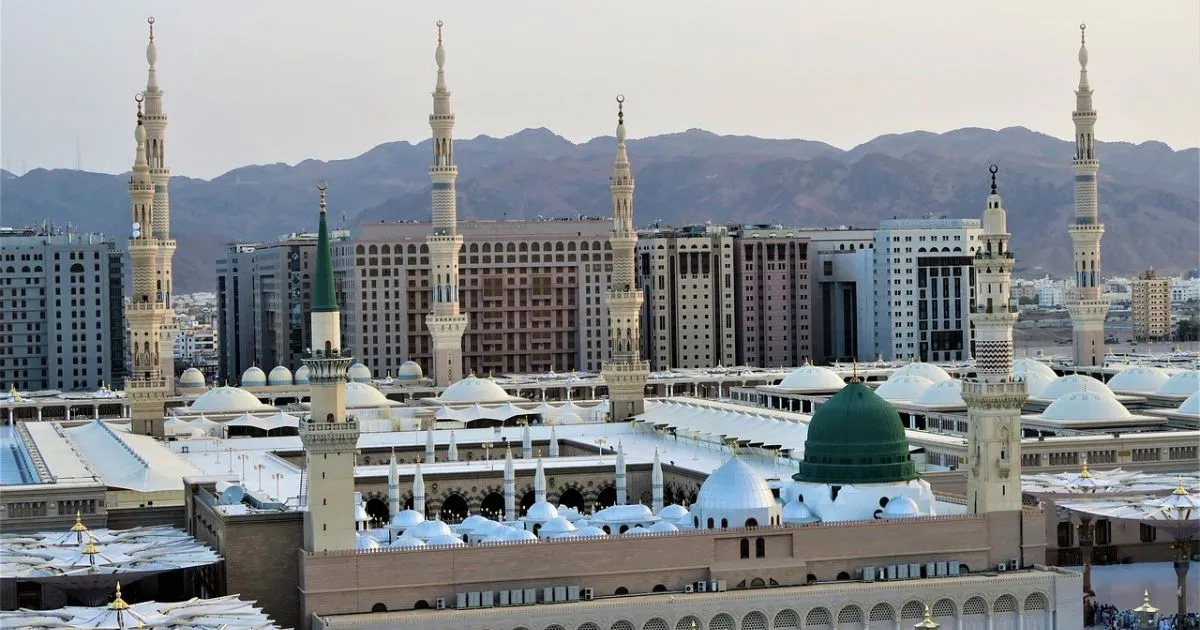Where is the city of Medina located in Saudi Arabia, and why is it significant?
Table of Contents
How does the location of Medina contribute to its historical and religious importance?
Exploring Medina shows how its location is key to its history and faith. It’s the second-holiest city in Islam, linked closely to Mecca, the holiest. This nearness made Medina a key spot for trade and commerce in the Arabian Peninsula.
The spot of Medina has molded its past and spiritual value, drawing folks from everywhere. Knowing how Medina and Mecca are connected helps us see the city’s value. As you learn about Medina’s history, you’ll see how its strategic spot has shaped it, especially its ties to Medina and Mecca.
Key Takeaways
- The location of Medina is crucial to its historical and religious significance.
- Medina is the second-holiest city in Islam, closely tied to Mecca.
- The proximity of Medina to Mecca has contributed to its importance.
- The location of Medina has shaped its history and religious significance.
- Understanding the relationship between Medina and Mecca is essential to grasping the city’s importance.
- The location of Medina has influenced its development, particularly in terms of trade and commerce.
- The connection between Medina and Mecca is vital to understanding the city’s role in Islam.
Where Is the City of Medina Located in Modern Saudi Arabia?
Exploring Medina’s history and significance requires knowing its location. Medina is in Saudi Arabia’s western part, in the Hejaz region. It’s close to Mecca, about 340 kilometers away.
Medina is in a valley, surrounded by mountains. This setting helped protect the city from invaders. The climate is hot desert, with little rain all year. Knowing Medina’s location helps us understand its importance in Arabia.
Geographical Coordinates and Climate
Medina’s coordinates are 24.4667° N, 39.5833° E. Summer is very hot, with temperatures up to 45°C. Winters are mild, between 10°C and 20°C.
Modern Infrastructure and Accessibility
Medina is now a major city with good infrastructure and easy access. It’s connected to other cities by highways. The city also has an international airport, especially busy during Hajj and Umrah.
| City | Geographical Coordinates | Climate | Accessibility |
|---|---|---|---|
| Medina | 24.4667° N, 39.5833° E | Hot desert climate | Highway network, international airport |
| Mecca | 21.3891° N, 39.8233° E | Hot desert climate | Highway network, international airport |
The Strategic Position of Medina in Ancient Arabia
Exploring the history of Medina reveals its key role in ancient Arabia. Its location made it a vital center for trade and commerce. It controlled trade routes between the East and West, exchanging goods and ideas.
Medina’s close tie to Mecca, Islam’s holiest city, added to its importance. It became a major spot for pilgrims and cultural exchange.
Throughout history, empires and dynasties have recognized Medina’s strategic value. Medina’s unique location helped it grow as a commercial and cultural center. Merchants and travelers from around the world were drawn to it.
Key factors made Medina stand out:
- Control of trade routes between the East and the West
- Proximity to Mecca, facilitating pilgrimage and cultural exchange
- A strategic location for the exchange of goods and ideas
Medina’s strategic position was crucial to its growth and importance. Its connection to Mecca and its role in ancient Arabia made it a center of activity. It influenced trade, commerce, and culture in the region.
Historical Trade Routes and Their Impact on Medina’s Development
Exploring Medina reveals its key spot on major trade routes. Its markets buzzed with global goods like spices, textiles, and metals. The city’s economy grew thanks to cultural exchanges with Romans, Byzantines, and Persians.
Medina was a vital link in ancient trade networks. Caravans from East to West passed through, making it a key stop for merchants. This exchange enriched Medina’s architecture, art, and literature, leaving a lasting mark. In Medina and Mecca, trade routes were crucial in shaping its history and growth.
Major Caravan Routes Through Medina
Some major caravan routes through Medina include:
- The Incense Road, connecting East and West
- The King’s Highway, linking Medina to other cities
- The Spice Route, bringing exotic spices to markets
These routes brought wealth and cultural exchange to Medina. Today, you can see the city’s rich history and cultural heritage. It was shaped by its location and trade routes.
| Trade Route | Origin | Destination |
|---|---|---|
| Incense Road | South Arabia | Mediterranean region |
| King’s Highway | Medina | Damascus |
| Spice Route | India | Mediterranean region |
The Relationship Between Medina and Mecca
Exploring Medina’s history and significance is key. It’s important to know its bond with Mecca, another holy city in arabia mecca madina. Medina was a major trade center, thanks to its close ties with Mecca. This connection makes Medina a crucial stop for Muslims visiting Saudi Arabia, especially during pilgrimage.
The history and religion tie Medina and Mecca together. Many Muslims visit both cities during their pilgrimage to Saudi Arabia. This shows the strong bond between medina and mecca. The two cities have also been economically and culturally connected, with Medina playing a big role in the region’s trade and commerce.
- Cultural exchange: The close proximity of Medina and Mecca has facilitated the exchange of ideas, customs, and traditions between the two cities.
- Economic ties: Medina has long been an important center for trade and commerce in the region, with Mecca also being a significant hub for economic activity.
- Religious significance: Both cities are considered holy in Islam, with Medina being the final resting place of the Prophet Muhammad and Mecca being home to the Kaaba, the holiest site in Islam.
In arabia mecca madina, the connection between Medina and Mecca shows the region’s rich cultural and religious heritage. As you learn more about these cities, you’ll understand their importance in the Islamic world and their lasting impact on the region.
Conclusion: Understanding Medina’s Enduring Significance in Islam
The location of Medina has been key to its history and faith. It’s the second-holiest city in Islam, attracting pilgrims and symbolizing the faith. Its spot in the Arabian Peninsula, near Mecca, and on trade routes has made it vital.
Medina’s culture and faith have left a deep mark. Its buildings, art, and literature show its unique history. Learning about Medina’s role in Islam helps us appreciate the faith more.
Exploring the location of Medina is interesting for anyone. It shows how faith, culture, and location shape civilizations. Medina’s lasting importance is a testament to these influences.
FAQ
Where is the city of Medina located in modern Saudi Arabia?
Medina is in the western part of Saudi Arabia, in the Hejaz region. It has coordinates of 24.4667° N, 39.5833° E. The city is in a valley, surrounded by mountains, and has a hot desert climate.
How does the location of Medina contribute to its historical and religious importance?
Medina’s location in the Arabian Peninsula made it key for trade and commerce. It attracted people from all over. Its closeness to Mecca, the holiest city in Islam, makes it the second-holiest city.
What were the major caravan routes that passed through Medina, and how did they impact the city’s development?
Medina was a key stop for caravans between the East and West. Its markets were full of goods from around the world. Before Islam, it was a major trade center for spices, textiles, and metals.
The city’s economy grew through cultural exchange with other civilizations along these routes.
How is the relationship between Medina and Mecca, and how has it shaped the religious and cultural significance of both cities?
Medina and Mecca have a long history and religious bond. Both are holy in Islam. Medina’s closeness to Mecca makes it a major pilgrimage site.
Both cities are economically and culturally linked. Medina is a key trade and commerce center in the region.

